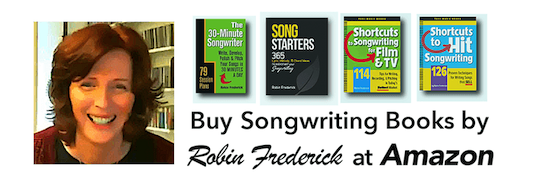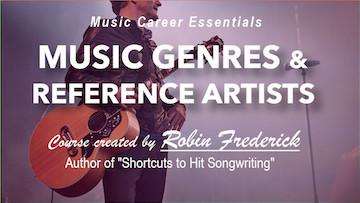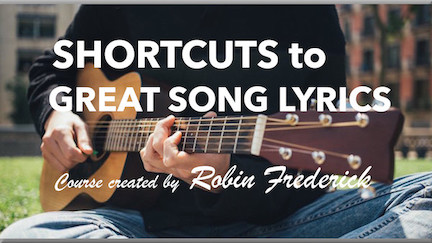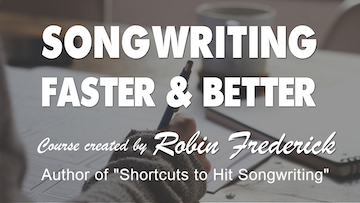“Don’t Start Now” is a great Disco-influenced Club Dance hit that I just couldn’t pass up. Dua Lipa can always be counted on to deliver solid songs that appeal to the Dance crowd and radio listeners as well.
Number 1 on the Dance Club and Top 40 charts, and on its way to a billion listens on Spotify, this is yet another score for Lipa, her cowriters, and producer. So, let’s find a few techniques you can try in your own dance hits.
Don’t Start Now” – Dua Lipa
Songwriters: Dua Lipa, Emily Warren, Ian Kirkpatrick, Caroline Ailin
TECHNIQUES TO HEAR AND TRY:
- Get fresh with song structure.
- Write a negative chorus lyric.
- Four ways to create melody contrast.
- Blend old with new production.
Listen to the song. Read the lyrics
GENRE/STYLE: Dance Club / Top 40
(What is a genre? Watch this video.)
“Don’t Start Now” does a great job of nailing the pure Dance Club style while adding plenty of Radio appeal. At 124 BPM (beats per minute) it features a classic Disco tempo and a fat four-on-the-floor fat kick drum and funk bass line that gets the audience out of their seats and onto the floor. There are playful instrumental hooks galore and an easy to sing-along-with chorus.
This is the type of song that music publishers seek out for the many up-and-coming singers who need material that will catch on in the clubs and then break through to radio, launching the singer’s career into orbit. If you want to pitch to mainstream music publishers, this is a style that will get you in the door.
SONG STRUCTURE
Here’s an example of the creative use of structure in today’s Dance genre. The song form is very carefully crafted but departs from the standard song forms we’re used to by adding what sounds like an extra pre-chorus. So, the structure looks like this…
- VERSE / PRE-CHO A / PRE-CHO B / CHORUS
- VERSE / PRE-CHO A / PRE-CHO B / CHORUS
- INSTRUMENTAL BRIDGE (1:58)
- PRE-CHO B / CHORUS
“Don’t Start Now” opens with a little taste of the song, just one line from Pre-chorus B, before launching into the first verse.
Here are the opening lines of each section.
VERSE 1: “Did a full 180, crazy…”
PRE-CHORUS A: “I’m all good already…”
PRE-CHORUS B: “If you don’t wanna see me…”
CHORUS: ‘Don’t show up, don’t come out…”
VERSE 2: “Aren’t you the guy who tried to…
DEFINE YOUR STRUCTURE WITH MELODY: Song structure is in the ear of the beholder, so how you hear this structure is up to you. To my ear, the verse melody is four lines long. At that spot, it seems to finish a melody and lyric thought.
VERSE 1:
Did a full 180, crazy
Thinking ’bout the way I was
Did the heartbreak change me? Maybe
But look at where I ended up
This is followed by a new melody idea that begins to build energy. Listen to these melody lines and you’ll hear a change in the rhythm of the notes, plus more note repetition and a melody that rises at the end—all hallmarks of a pre-chorus.
PRE-CHORUS A
I’m all good already
So moved on, it’s scary
I’m not where you left me at all, so
This is followed by a section that seems to hold its breath, building suspense. It seems to say, “Wait for it…”
PRE-CHORUS B
If you don’t wanna see me dancing with somebody
If you wanna believe that anything could stop me
The floating feel of Pre-chorus B delivers us right into an energetic, punchy chorus, taking full advantage of a track structure that is common in Dance Club hits: the break and drop. Notice how the instrumental beat empties out under pre-chorus B (the break) and then comes back in (the drop) for the chorus. The Dance Club market will react very positively to the break and drop in the track, and radio listeners like it, too.
Find out more about Dance Club song structure in this video.
– Try It Now –
Listen to the song and decide for yourself where the verse ends. Notice what the instrumental track is doing underneath pre-chorus B and the chorus. In what way do those two sections feel different?

LYRICS

USING NEGATIVE CHORUS LYRICS: I’ve heard it said that a chorus lyric should never be negative, but obviously this one is, and it works! So, why is that? Here are a couple reasons.
1. The second line of the chorus justifies the first line. If you’re going to go negative, quickly let the listener know that the singer has good reason to feel that way. Obviously, the other person didn’t treat the singer well; he didn’t care about her.
Don’t show up, don’t come out
Don’t start caring about me now.
2. The singer comes across as honest and thoughtful. In the first verse, we hear the singer wondering “Did the heartbreak change me?” She has “moved on” and “I’m not where you left me.” She comes across as someone who is examining her own motives and is honest with herself (and us) before we ever get to the negative chorus. So, when we do finally hear it, it sounds like the singer is showing strength of character and the ability to stand up for herself.
TIP: Listeners might miss the first verse entirely, only tuning in to the song’s lyric when the chorus grabs their attention. Notice how the second verse reinforces the reasons why the singer feels as she does. (“Aren’t you the guy who tried to hurt me?”) Keep that message in front of the listener. Make your singer relatable and sympathetic. By the second chorus, listeners will be cheering her on.
PUT YOUR RHYMES TO WORK: There is a very clever rhyming trick going on in the verses of this song. Listen to the first verse and notice the rhymes: “180…crazy…change me…maybe.” Now notice how each of these rhyming words/phrases lands on a pair of notes that echo other pairs—different note pitches, same note rhythms. It makes these lines incredibly catchy and easy to remember.
If you’ve created lyric candy like this in your first verse, listeners will want (and expect) you to do it again in the second verse. This is a good thing because it means listeners will stick around for the second verse. But it’s a not-so-good thing because now you have to do it again! This has stumped many a songwriter but these writers deliver the goods in Verse 2: “guy who…tried to…time to…survive you.”
In spite of the tight rhyme scheme, the language feels conversational, as if the singer is just saying what’s on her mind. You never get the feeling that a line was forced to accommodate a rhyme. It adds a sense of authenticity to the song, as if the singer just thought of what she’s saying. The trick to doing this is to rely on vowel rhymes—rhymes with the same vowel sound in the emphasized syllable. Nothing else matters but that vowel: 180/crazy/change me/maybe. Got it?
MELODY
This song provides some solid ideas for writing melody in today’s Pop styles. Your song sections may be longer than the ones here but the ideas for creating well-defined melody sections can be applied to any length.
CREATE CONTRAST BETWEEN SECTIONS: A song with four melody sections (Verse, Pre-chorus A, Pre-chorus B, Chorus) could be confusing and hard to remember. The songwriters avoid that problem by creating a distinct, well-crafted melody for each section.
~ 1. The verse melody is a series of discreet, short phrases, some as short as two notes. (See RHYMES above.) There’s also a strong sense of down/up motion in this melody.
~ 2. This is followed by a section in which the phrases run into each other, creating the feeling of one long line. (“I’m all good already/So moved on it’s scary/I’m not where you left me at all.”) In contrast to the verse melody, many of the notes in this section sit on the same pitch.
~ 3. The next melody section (“If you don’t wanna see me…”) consists of two long, flowing lines with plenty of interval jumps in the pitches, very different from the previous song sections.
~ 4. Finally we come to the chorus, with its punchy, short phrases, almost no motion in the pitches at all, and tons of repetition. Again, this melody is unlike the other melody sections.
Read more about using contrast in your melody.
– Try It Now –
Listen to each song section as you re-read my description of the melody. Look for the differences in how phrase length, note pitch, note rhythm, and repetition are handled in each one. By juggling these four elements, the songwriters have created a clear song structure that maintains focus and makes the song easy to remember.
CHORDS
“Don’t Start Now” is a four-chord song, but unlike many recent hits which simply cycle through the same set of chords in the same order, this progression changes from one section to the next to accommodate the melody.
You can buy an instrumental version on Karaoke-Version.com.
-Try It Now –
Learn to sing this song (play along or sing it to the track) to embed the melody and lyric style. Write a few lyric lines of your own to the melody to see how they sound and get a feel for the style.
PRODUCTION

OLD AND NU: Wikipedia refers to this song as “nu-disco” and I totally agree! There are plenty of contemporary sounds and samples slammed up against the disco strings and “whoop whoop” of any number of mid-1970s Disco hits. (And I swear I heard a cowbell in there.)
The rhythm tracks, funk bass line, and synth chords in the song “Don’t Start Now” are locked tightly together and to the underlying beat, yet the track preserves a comfortable human swing. If you’re interested in updating older Dance Club productions, this is a good track to study. For more insights into the production, check out this article in Wikipedia.
WHEN WILL THE BASS DROP?!! Dance tracks have a well known structure embedded in the instrumental arrangement. The break, build, and drop of successful Club tracks is a familiar, much anticipated highlight of the instrumentals that dominate this genre. For more on this style, watch my YouTube video: Dance Track & Song Structure
READ MORE HIT SONG GUIDES ON THIS SITE and learn from the hits!



